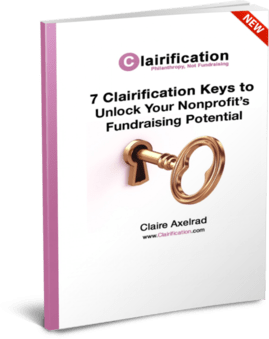
Help donors bust out and passionately enact their values
I’ve recently been enrolled in some coaching courses, and it got me thinking…
What if you were to think of yourself as the coach and the donor as your client?
As a coach (aka “philanthropy facilitator”), your goal would be to help that client.
This is a very different stance than approaching them as someone who will help you. It completely shifts the equation of your interactions.
I’ve been working with donors, and organizations working with donors, for forty years now. Along the way, one of the things I’ve learned is your approach to your work matters. It’s why I talk a lot about reframing.
- Philanthropy, not fundraising.
- Storytelling, not asking.
- Gratitude, not greed.
- Abundance, not scarcity.
- Helping, not selling.
Today I’d like to discuss another type of reframing. It has to do with using your ears and mouth in the proportion in which they were given to you.
How to reframe the borders of donor meetings.

What might you do to nurture and lift up your donor to help them grow towards the light?
What if the goal were to serve the donor’s interests as much as you serve your own?
Here is a framework you might use to guide your conversations. This also works well as a framework for staff and volunteer meetings, particularly brainstorming and idea generation sessions. You might also think of it as a “container” for safe, respectful, valued dialogue.
Goal: To guide a client/donor to their own inner wisdom, power and possibility.
Foundation/Guidelines: Set aside anything you think you know about the client/donor. Show up with attention, curiosity and openness.
Stance: Value the power of the “container” and sense of being a “loving witness.” Come from a place of reverence for the client/donor. Be an attentive listener, showing “you matter.”
Practice: The value of the meeting comes both from the quality of your listening and from the questions you ask. Ask intentional, directional questions. Keep them simple, spacious and open-ended. Every question sends the client/donor somewhere. Where do you want to send them? It’s not to doing what you want them to do. Rather, it’s to a place within themselves — towards their own clarity, integrity, compassion and wisdom – making them want to do something they want to do. For example: “What would your dream be?”
There are different levels of listening.
I’ve learned through my coaching courses there is more than one way to approach a meeting. When you’re in coaching – or philanthropy facilitation – mode, it’s not simply a conversation. It’s a type of energy work.
Listening Levels:
- Chit-chat or conversation that springs from your own agenda.
- Deeper listening to hear what’s true for the client/donor.
- Deep awareness of body language, tone of voice and how the donor may be feeling underneath what they’re saying. People don’t actually get a lot of opportunities to be listened to this way. It’s something people yearn for. A way to slow things down. Leave enough space to potentially be completely surprised by what happens in the conversation and interaction. If you aren’t surprised, or don’t learn something new, perhaps you haven’t deeply listened.
Be brave about departing from just chit-chat. Use listening and language as tools to help the donor shift their stance, energy, and closeness to their own sense of possibility. See donors as the heroes of their own journey, with you standing by their side as support. Through attentive listening, give them tools to approach the issue from their own wisdom. See them as sacred, precious and full of potential.
Talking with donors is not easy work.

What might you do to connect and link intricate branches to a greater whole?
Sometimes conversations veer away from where you thought you were going.
It can be gnarly. Things may come up that may make you uncomfortable. That’s okay. When this happens, consider how you want to meet this situation. You can’t change another person’s situation or personality or lived patterns of approaching life. You can help them find something around which they have agency.
EXAMPLE: I used to work with a constituency of Holocaust survivors, and sometimes their stories took us into territory I felt unequipped to address. I tried to give them space to talk about their life, but constantly found myself flipping into a Level One type of listening where my own thoughts invaded. I thought to myself: “This seems linked to major trauma… should I be referring them to a therapist?” “Am I going to say something inadvertently that may trigger problematic feelings?” “I just don’t know what to say here; I’m not trained or informed enough.”
Too often, when I got to this point, I would shut the conversation down. Today I am so sorry I did this. What if I had understood I neither had to relate to their story to understand, nor did I have to resolve their issues? All I had to do was provide a “container” and be a loving witness. Fortunately, sometimes I listened deeply. I remember one person in particular, whose story I listened to for a solid hour. At the end, I said “Is there anything we at the Agency can do to help you heal or find some peace?” The answer? “Help me fund a program to teach young people about the Holocaust so it is never forgotten and never happens again.” It wasn’t what I was planning to ask for. It was a MUCH BIGGER commitment. The donor wanted to entwine their grown branch with the growing branches of future generations, in a positive light.
Deep listening is a muscle that needs to be built and exercised.
Sometimes helping donors means slowing things down. In a rush to get to the ask, or get out of an uncomfortable place, we can cut the exchange short. Do you ever do this? If so, try to be more self-aware. Your job is not to “fix” things. It’s to provide a receptive, attentive, compassionate space. This may enable the donor to connect to deeply lived, resonating experiences. From this space, you may be able to help them get in touch with their own values. Sometimes it’s as simple as reflecting back what you hear. “Here’s what I sense from what you’re saying. Is that right?”
You may be able to ask donors how they’d like to move forward to live their values. You may even ask them “how can we help you?” You’re not necessarily asking them if they need something tangible like home care (if you provide that) or a ride to a doctor’s appointment or upcoming event; you may be asking how you can help them move forward, enacting their values, from a place of love.
Donor conversations are collaborative work.

There are many routes along the pathway to passionate philanthropy.
You don’t know the right path for your donor.
You may have some ideas about what you’d like to present as a funding possibility. But that’s beginning at the end. Actually, an end. It’s only one of many possibilities. And it’s something you’ve reached without inviting the donor to share any personal wisdom and ideas they may have.
If you ask a donor for $10,000 for project A, and they say “no, but I’d love to give you $20,000 for project B,” would you say “No, that’s not what we’re raising money for right now?”
What if you thought of meeting with donors as a co-creative process?
You’ll have ideas, of course. Especially if you have a particular program that needs funding or a campaign with a goal that needs to be reached. Yet what if you provided space for the donor to share their ideas as well? What if you listened for what truly animated the donor’s passion, then gently guided them to explore this passion further?
EXAMPLE: Once early in my career I proposed a project I was sure a major donor would love to fund. It was a new program on our drawing board, and it needed $30,000 seed funding. This was not outside the realm of possibility based on this donor’s previous giving history. I set up a meeting and brought in all the resources at my disposal. The executive director. The program director. We “pitched.” The donor listened politely, then said: “Not really my area of interest; I’ll give you $1,000 if you get the rest.” It was that place in the movie where the music comes to a screeching halt. We said thank you, folded up our tents, and left.
I now know I should have guided the donor through questions that brought them to a more receptive space. “What is your area of greatest interest today?” “If this is not the right program to help you enact your values, do you see a program that may resonate with you more deeply?”
Commit to meet the donor where they are.

Remember and make this your mantra:
Ask not what your donor can do for you, but what you can do for your donor.
This is a gift you can give. And if you’re familiar with my work, I often say “if you want gifts you must give them.”
Engage with the donor’s own beauty and preciousness. Deeply listen, in the present. Live with that existing energy, and pledge to move it forward.
— You’ll feel better about your work.
— The donor will feel better about themselves.
— The donor will feel better about you and your cause.
— The donor will act from a place of inner wisdom, possibility and passion.
— The world will become a place of greater compassion, strength and balance.
Want to Unlock More Passionate Philanthropy?
 7 Clairification Keys to Unlock Your Nonprofit’s Fundraising Potential offers a wealth of materials to help you develop the necessary mindset, and supporting infrastructure, to show donor-investors what’s in it for them to affiliate with you. This 42-page e-book is broken into seven sections. Each includes one or more worksheets or exercises to help you put concepts into action. Some of the worksheets are intended as individual exercises; a few are suited to groups. And you also receive a Resource Guide with a ton of useful links. If you don’t find it useful, I offer a 30-day, no-questions-asked, money back guarantee.
7 Clairification Keys to Unlock Your Nonprofit’s Fundraising Potential offers a wealth of materials to help you develop the necessary mindset, and supporting infrastructure, to show donor-investors what’s in it for them to affiliate with you. This 42-page e-book is broken into seven sections. Each includes one or more worksheets or exercises to help you put concepts into action. Some of the worksheets are intended as individual exercises; a few are suited to groups. And you also receive a Resource Guide with a ton of useful links. If you don’t find it useful, I offer a 30-day, no-questions-asked, money back guarantee.
Photos by Claire Axelrad, Tomáš Malík, Quang Nguyen Vinh, Tina Nord and by Piotr Arnoldes from Pexels.






Good read!